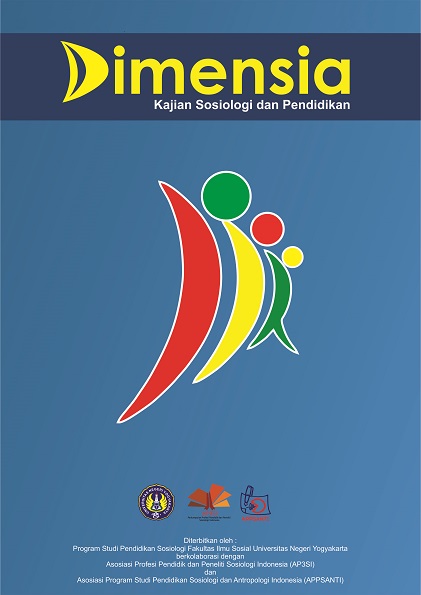FENOMENA TARI TAYUB DI KECAMATAN JATIROGO KABUPATEN TUBAN
DOI:
https://doi.org/10.21831/dimensia.v6i1.3366Abstract
Tayub is a traditional dance popularized in Kecamatan Jatirogo, Kabupaten Tuban. Tayub dance usually performed in the wedding party, circumcision, and bersih desa which aim to get the fertility. This tayub dance performance is closely related to the social divergence, social labeling, and the effect which is emerged. This study aim to describe the factors considered that tayub is divergent from the public norm which causes social labeling and influences the existence on the profession of ledhek and the effect of tayub dance performance either to ledhek or community in Kecamatan Jatigoro, Kabupaten Tuban
This study is a qualitative descriptive which the primary data resource consisted of ledhek, pengibing, and public figure. The secondary data resource was collected by using documentation and references. The data were collected by: observation, interview, and documentation. The sampling technique used was the purposive sampling. The validity of data used the triangulation and method. In addition, the data analysis consists of several steps, such as data collection, data reduction, presenting data, and conclusion.
This study showed that tayub dance is performed in two sessions; in the midday and night. Tayub and ledhek still exist at the time. It has been shown that the Tuban local government in every year invites the ledhek to be a representative dancer of East Java simultaneously to intend the Culture program in Jakarta, even performs in TMII. In addition, it has been a fundamental program of the Tuban celebration.
Tayub dance performed in the wedding party, circumcision, and purified village ritual are believed to be able to influence the fertility. Tayub dance has a manifest and a laten functions. The manifest function can be considered from its purpose that is gratitude, and keep the good relationship between the figure and its community. The latent function considered from the public divergence, labeling and the effect of tayub dance. The effects of its divergence are sawer (has not been allowed by Tuban government since 2003), drinking alcohol, conflict, and an affair. This social divergence emerges the social labeling on ledhek either positive or negative. Tayub dance has a positive and negative effect to either ledhek or its community. The positive effect can be considered from the high financial reached by the ledhek. Ledhek has an experience performed in Jakarta. On the other hand, the negative effect emerges the negative labeling from the public.
Keywords: Tayub, ledhek, social divergence, labeling, effect
Downloads
Published
How to Cite
Issue
Section
License
Penulis yang menerbitkan jurnal ini menyetujui ketentuan berikut:
- Penulis memegang hak cipta dan memberikan hak publikasi pertama kepada jurnal dengan karya tersebut secara bersamaan dilisensikan di bawah Lisensi Atribusi Creative Commons yang memungkinkan orang lain untuk berbagi karya dengan pengakuan atas kepenulisan karya dan publikasi awal di jurnal ini.
- Penulis dapat mengadakan perjanjian kontrak tambahan yang terpisah untuk distribusi non-eksklusif dari karya versi terbitan jurnal (misalnya, mempostingnya ke repositori institusi atau menerbitkannya dalam buku), dengan pengakuan atas publikasi awalnya pada tahun jurnal ini.
- Penulis diizinkan dan didorong untuk memposting karya mereka secara online (misalnya, di repositori institusi atau di situs web mereka) sebelum dan selama proses penyerahan, karena hal ini dapat mengarah pada pertukaran yang produktif, serta kutipan karya yang diterbitkan lebih awal dan lebih banyak (Lihat The Pengaruh Akses Terbuka).
====================================================
Authors who publish with this journal agree to the following terms:
- Authors retain copyright and grant the journal right of first publication with the work simultaneously licensed under a Creative Commons Attribution License that allows others to share the work with an acknowledgement of the work's authorship and initial publication in this journal.
- Authors are able to enter into separate, additional contractual arrangements for the non-exclusive distribution of the journal's published version of the work (e.g., post it to an institutional repository or publish it in a book), with an acknowledgement of its initial publication in this journal.
- Authors are permitted and encouraged to post their work online (e.g., in institutional repositories or on their website) prior to and during the submission process, as it can lead to productive exchanges, as well as earlier and greater citation of published work (See The Effect of Open Access).







